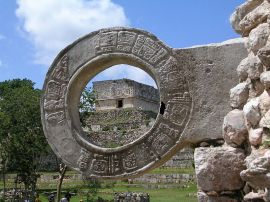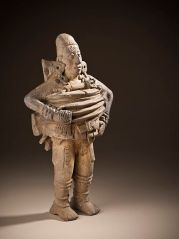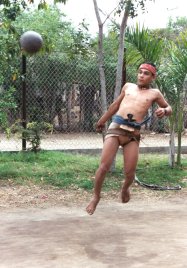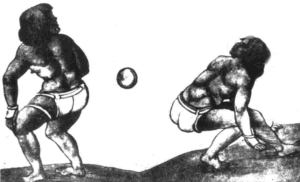Blog Archives
4. The Hip Parade: Ball games in Pre-Colombian Central and Caribbean America
The stories of players having their heads chopped off as told by Mexican tour guides masquerading as university professors are just the kind of thing to keep their punters interested and earn a few extra dollars in tips, but are not necessarily to be taken too literally.
Throughout the Americas, ball sports already existed long before white settlers appeared to change life in the continent forever. The best known of these is the ‘Mesoamerican ballgame’, which was played by such civilizations as the Olmec, Maya and Aztec.
Most ancient ball games were played on improvised fields and left very little physical evidence, but this one was different. It was played in purpose-built ballparks, and the remains of about 1,400 can still be visited today – the most famous and spectacular of all being the 168x70m Great Ball Court built by the Maya at Chichen Itza.
 Other evidence, including carved figurines, inscriptions on the ballparks and the descriptions written by Spanish conquistadores, provide a fairly detailed picture of such games as the Maya pok-ta-pok and the Aztec ullamaliztli, as well as the batey played by the Taino people in the Caribbean islands, which shared many of the same characteristics. And one of the most unusual of these is that in most forms of the Mesoamerican ballgame, the two most logical methods for striking the ball, kicking and throwing, were usually illegal. Instead, players used their hips, buttocks and other parts of the body to knock the remarkably bouncy rubber ball back and forth.
Other evidence, including carved figurines, inscriptions on the ballparks and the descriptions written by Spanish conquistadores, provide a fairly detailed picture of such games as the Maya pok-ta-pok and the Aztec ullamaliztli, as well as the batey played by the Taino people in the Caribbean islands, which shared many of the same characteristics. And one of the most unusual of these is that in most forms of the Mesoamerican ballgame, the two most logical methods for striking the ball, kicking and throwing, were usually illegal. Instead, players used their hips, buttocks and other parts of the body to knock the remarkably bouncy rubber ball back and forth.
 The exact rules of the game are unknown, but they clearly varied in different eras and cultures from something resembling squash or tennis to something more like basketball, where the idea was get the ball through a stone ring – a seemingly impossible task. The players were sometimes depicted wearing hefty yokes around their waists, covering their hands with large gauntlets or donning helmets, suggesting it could get extremely violent.
The exact rules of the game are unknown, but they clearly varied in different eras and cultures from something resembling squash or tennis to something more like basketball, where the idea was get the ball through a stone ring – a seemingly impossible task. The players were sometimes depicted wearing hefty yokes around their waists, covering their hands with large gauntlets or donning helmets, suggesting it could get extremely violent.
Although some Spanish chroniclers spoke of their admiration for the sport, it was generally condemned as a barbaric evil, both for the violence among the participants and for the gambling among the spectators. But we need to be careful how we interpret these descriptions, for it was common practice among the conquistadores to paint a negative picture of native customs in order to justify the genocide to which they subjected the civilisations they conquered.
 The images of sacrifices and decapitations on several ballparks have led to the claim that losing captains or whole teams were executed after games. Or even that it was winning captain who lost his head, which was considered a major honour. But we cannot be sure that these killings were actually part of the game, or just a Pre-Columbian form of pre-match entertainment. And although the game has been likened to gladiatorial combat, in which captives were forced to play to the death as entertainment, several instances were recorded when the ruling classes also played the game. Much of what is claimed as fact about the Mesoamerican ballgame is really little more than conjecture.
The images of sacrifices and decapitations on several ballparks have led to the claim that losing captains or whole teams were executed after games. Or even that it was winning captain who lost his head, which was considered a major honour. But we cannot be sure that these killings were actually part of the game, or just a Pre-Columbian form of pre-match entertainment. And although the game has been likened to gladiatorial combat, in which captives were forced to play to the death as entertainment, several instances were recorded when the ruling classes also played the game. Much of what is claimed as fact about the Mesoamerican ballgame is really little more than conjecture.
The Mesoamerican ballgame was driven underground and into extinction fairly rapidly following the arrival of the Europeans. But it never disappeared entirely. Ulama, a game played with a rubber ball in which the ball cannot be struck with either the hands or feet is still played in the Mexican state of Sinaloa and provides clues as to what the ancient sport was really like.
Click here to read the full chapter on the Mesoamerican ballgame in Mike Roberts’ The Same Old Game.
5. LITTLE BROTHERS OF WAR: Ball games in Pre-Colombian North America

